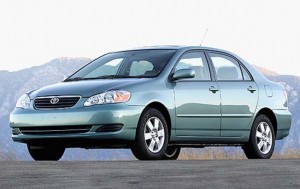Still struggling to deal with the fallout from the controversial recall of 3.8 million vehicles, Toyota is facing the challenge of yet another federal safety probe. Government regulators are probing complaints that some of the automaker’s vehicles may stall in traffic, sometimes at high speed.
Long known for bullet-proof reliability, the growing number of problems attributed to various Toyota products threatens to tarnish the automaker’s carefully-cultivated image.
Complicating the situation is an ongoing battle with a whistle-blower claiming the Japanese giant has hidden damaging evidence connected to potential vehicle rollover problems.
The latest problem involves one of Toyota’s most popular models, the Corolla, as well as the compact Matrix crossover. According to the National Highway Traffic Safety Administration, it has so far received 26 complaints that versions of those two models produced during the 2006 model year experience “stalls occurring randomly while driving, including some on highways and some in intersections.”
The government’s files show that some instances of stalling occurred in potentially dangerous situations, where vehicles could have been struck by other traffic. In one case, a stalled Corolla blocked a busy right turn lane for two hours.
NHTSA is looking to see if the problem is connected to a previous step Toyota took on its own to resolve a problem with harsh shifting on the two vehicles. The maker issued a service bulletin, in 2007, calling for the replacement of an electronic control module.
A total of 397,000 vehicles could be involved. A safety investigation, such as this one, does not mean that a recall will follow.
Ironically, neither the Corolla nor Matrix are involved in the recall of 3.8 million Toyota and Lexus products. Triggered by a fiery August crash that killed a California state trooper and three members of his family, Toyota announced, in August, that improperly installed floor mats could jam a vehicle’s accelerator pedal. It asked owners to remove those mats and plans to conduct a two-step recall. Initially, dealers will saw off the bottom ¾-inch of the gas pedal. A replacement pedal will be installed after it becomes available, next April.
The government has not completely closed the books on the problem, however, and is still looking at the design of Toyota floor pans. Meanwhile, a number of lawsuits, including at least one class action, have been filed against the automaker, some claiming the unintended acceleration problem is caused by a mysterious electronic gremlin.
The latest problem with the Corolla and Matrix could add fuel to such concerns, though to date, there has been no evidence to suggest that electronic control systems are at fault. Similar complaints were raised, 20 years ago, in connection with the Audi 5000 sedan. Eventually, however, federal regulators ruled the vehicle safe and any instances of unintended acceleration were the result of driver error.
Several Toyota officials, speaking privately and asking not to be identified, have told TheDetroitBureau.com they expect a similar outcome, with the accelerator pedal fix being recognized by regulators as the full “fix.”
But the officials also acknowledged that the rash of headlines involving the automaker threaten to damage its reputation. So far this year, the automaker has said it will recall a total of 4.8 million vehicles in the United States, more than four times more than in any previous year. It recalled 1.1 million vehicles in 2004.
Along with the 3.8 million vehicles involved in the floor mat/accelerator pedal recall, another 110,000 Tundras are being recalled due to problems with excessive corrosion that could cause brake failure – or spare tires to fall off the vehicle.
The NHTSA also is looking at 2003 Sequoia crossover vehicles in response to complaints that the stability control system can engage erratically, leading to loss of control.
Meanwhile, a former Toyota attorney alleges that Toyota has withheld evidence in a number of lawsuits connected with vehicle rollovers that might have supported owners’ claims of a design flaw.
As if to add insult to injury, Toyota has suffered a number of setbacks in recent quality and related studies. One of the most recent is the Total Vehicle Index, from the research firm Strategic Visions. Designed to measure not only quality but value and desirability, not one Toyota product led an individual vehicle segment.
A Strategic Vision spokesman called the data “a revolution,” and other industry analysts are warning that Toyota is at increasing risk of losing its cherished image as industry’s safest and most reliable brand.

